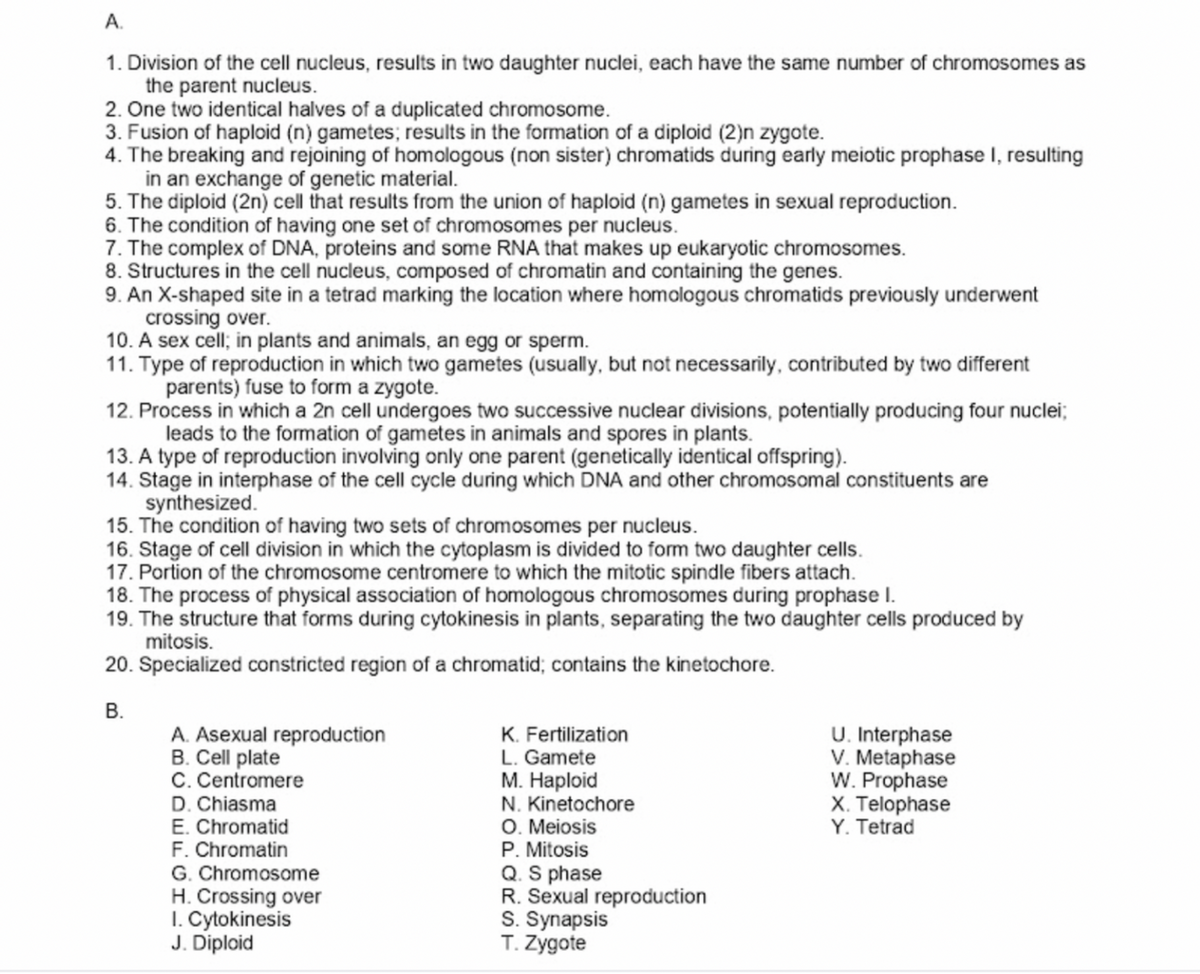1. Division of the cell nucleus, results in two daughter nuclei, each have the same number of chromosomes as the parent nucleus. 2. One two identical halves of a duplicated chromosome. 3. Fusion of haploid (n) gametes; results in the formation of a diploid (2)n zygote.
1. Division of the cell nucleus, results in two daughter nuclei, each have the same number of chromosomes as the parent nucleus. 2. One two identical halves of a duplicated chromosome. 3. Fusion of haploid (n) gametes; results in the formation of a diploid (2)n zygote.
Biology 2e
2nd Edition
ISBN:9781947172517
Author:Matthew Douglas, Jung Choi, Mary Ann Clark
Publisher:Matthew Douglas, Jung Choi, Mary Ann Clark
Chapter13: Modern Understandings Of Inheritance
Section: Chapter Questions
Problem 3VCQ: Figure 13.6 Which of the following statements about nondisjunction is true? Nondisjunction only...
Related questions
Question
Instruction: MATCHING TYPE

Transcribed Image Text:A.
1. Division of the cell nucleus, results in two daughter nuclei, each have the same number of chromosomes as
the parent nucleus.
2. One two identical halves of a duplicated chromosome.
3. Fusion of haploid (n) gametes; results in the formation of a diploid (2)n zygote.
4. The breaking and rejoining of homologous (non sister) chromatids during early meiotic prophase I, resulting
in an exchange of genetic material.
5. The diploid (2n) cell that results from the union of haploid (n) gametes in sexual reproduction.
6. The condition of having one set of chromosomes per nucleus.
7. The complex of DNA, proteins and some RNA that makes up eukaryotic chromosomes.
8. Structures in the cell nucleus, composed of chromatin and containing the genes.
9. An X-shaped site in a tetrad marking the location where homologous chromatids previously underwent
crossing over.
10. A sex cell; in plants and animals, an egg or sperm.
11. Type of reproduction in which two gametes (usually, but not necessarily, contributed by two different
parents) fuse to form a zygote.
12. Process in which a 2n cell undergoes two successive nuclear divisions, potentially producing four nuclei;
leads to the formation of gametes in animals and spores in plants.
13. A type of reproduction involving only one parent (genetically identical offspring).
14. Stage in interphase of the cell cycle during which DNA and other chromosomal constituents are
synthesized.
15. The condition of having two sets of chromosomes per nucleus.
16. Stage of cell division in which the cytoplasm is divided to form two daughter cells.
17. Portion of the chromosome centromere to which the mitotic spindle fibers attach.
18. The process of physical association of homologous chromosomes during prophase I.
19. The structure that forms during cytokinesis in plants, separating the two daughter cells produced by
mitosis.
20. Specialized constricted region of a chromatid; contains the kinetochore.
K. Fertilization
L. Gamete
M. Haploid
N. Kinetochore
O. Meiosis
P. Mitosis
Q. S phase
R. Sexual reproduction
S. Synapsis
T. Zygote
U. Interphase
V. Metaphase
W. Prophase
X. Telophase
Y. Tetrad
A. Asexual reproduction
B. Cell plate
C. Centromere
D. Chiasma
E. Chromatid
F. Chromatin
G. Chromosome
H. Crossing over
I. Cytokinesis
J. Diploid
B.
Expert Solution
This question has been solved!
Explore an expertly crafted, step-by-step solution for a thorough understanding of key concepts.
This is a popular solution!
Trending now
This is a popular solution!
Step by step
Solved in 2 steps

Recommended textbooks for you

Biology 2e
Biology
ISBN:
9781947172517
Author:
Matthew Douglas, Jung Choi, Mary Ann Clark
Publisher:
OpenStax

Human Heredity: Principles and Issues (MindTap Co…
Biology
ISBN:
9781305251052
Author:
Michael Cummings
Publisher:
Cengage Learning

Concepts of Biology
Biology
ISBN:
9781938168116
Author:
Samantha Fowler, Rebecca Roush, James Wise
Publisher:
OpenStax College

Biology 2e
Biology
ISBN:
9781947172517
Author:
Matthew Douglas, Jung Choi, Mary Ann Clark
Publisher:
OpenStax

Human Heredity: Principles and Issues (MindTap Co…
Biology
ISBN:
9781305251052
Author:
Michael Cummings
Publisher:
Cengage Learning

Concepts of Biology
Biology
ISBN:
9781938168116
Author:
Samantha Fowler, Rebecca Roush, James Wise
Publisher:
OpenStax College